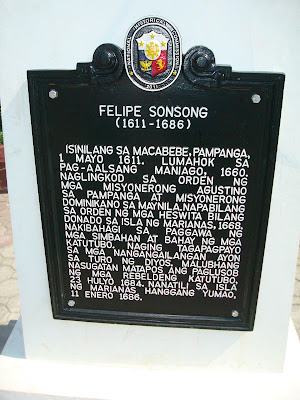The Filipino people, as we know, are made up of different groups, each with their own language. Tagalogs, Visayans, Ilocanos - to name a few. But, among them all, the people of Pampanga province may have the most connection to our islands. And in that province, perhaps the town of Macabebe ranks in the top tier.
The Pampanga people, called Kapampangan, were at first fiercely opposed to the Spaniards but ended up being their most fervent allies. When Blessed Diego Luis de Sanvitores was in the Philippines planning his eventual mission to the Marianas (then still called the Ladrones), a Kapampangan layman from Macabebe named Felipe Sonsong joined Sanvitores' missionary team. Other Kapampangan men also joined Sanvitores in his expedition to the Marianas.
Sonsong, an older widower by then, spent 18 years in the Marianas as a lay volunteer, a donado, of the Jesuits, working with great dedication, humility and piety. Among other tasks, he sewed and mended : altar cloths, clothing for the Chamorros and the missionaries.
In one of the last major episodes of anti-missionary violence, Sonsong was mortally wounded, in 1684 at the age of 77. He died from these wounds six months later. He had such a saintly reputation that the Spanish Governor himself helped bury Sonsong's body.
 |
| Monument to FELIPE SONSONG in front of Macabebe's Church Notice the mention of the MARIANAS several times |
KAPAMPANGAN SOLDIERS MARRY CHAMORRO WOMEN
Besides missionaries, soldiers accompanied the Jesuits; at first, a small contingent to protect them, and when warfare broke out, more soldiers were added over the years. About half of these soldiers were from Pampanga; they were Filipino, not Spaniards. It isn't surprising that these Filipino soldiers were Kapampangan, since that province was very loyal to Spain. These soldiers settled permanently on Guam, many of them marrying Chamorro women. Their blood runs through many of our veins. I wouldn't be surprised if some or many of these Kapampangan soldiers came from Macabebe, the town of Felipe Sonsong, or the other towns that orbit it.
IN SAIPAN :
I TIEMPON MACABEBE
Fast forward to 1899. The Spanish-American War had ended, with Guam and the Philippines going to the United States. But the Northern Marianas were still in Spanish hands. To govern the Spanish Northern Marianas was sent a man from Macabebe, Eugenio Blanco y Leison, 270 of his Macabebe Volunteers and their families - a total of some 700 people!
 |
philippineamericanwar.webs.com |
MACABEBE SOLDIERS 1900
Blanco was a mestizo landowner from Macabebe who had fought for Spain. When Spain lost the war with the U.S., the idea was for Blanco and his men to move to Saipan, the new capital of the Spanish Northern Marianas. Remember that Saipan's population at the time was just a couple thousand, so the addition of 700 more mouths to feed was a great drain on the island's resources. The cattle stock on Tinian was seriously depleted during Macabebe times because 2 heads a day had to be shipped from Tinian to Saipan to feed the troops and their families. It seems the Macabebes moved in with local families, placing terrible burdens on them. The local population felt so terrorized by the Macabebes that the Chamorros who could do so fled to Guam and the Carolinians isolated themselves outside of Garapan (the main town) as much as they could. The Saipanese were glad to see them leave when the Germans took over in November of 1899.
The Macabebes were on Saipan for just six months, but those times were so bad that I remember speaking to an older Saipanese man about how the man åmko' spoke about the horrors of I Tiempon Macabebe.
The Blanco House in Macabebe.
Abandoned now and in slight disrepair. The town mayor bought it and plans to restore the façade.


No comments:
Post a Comment